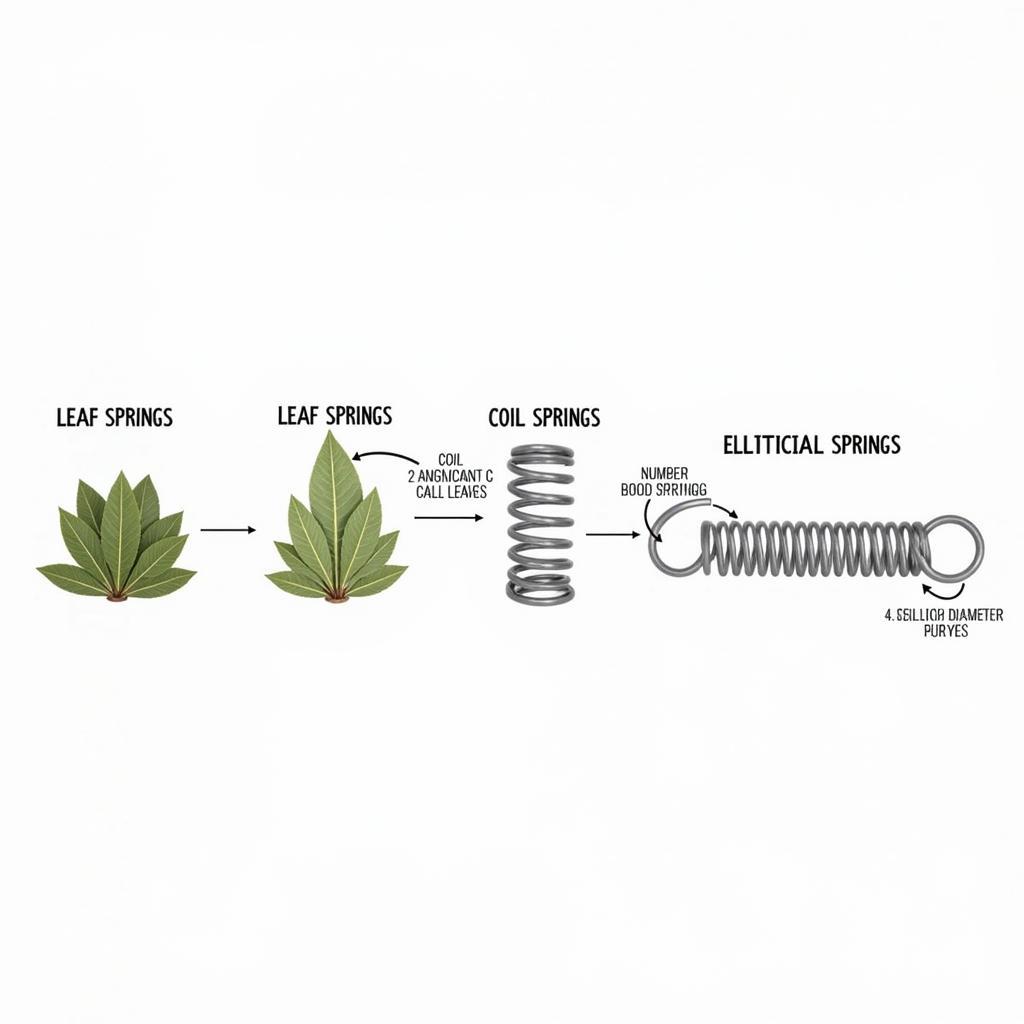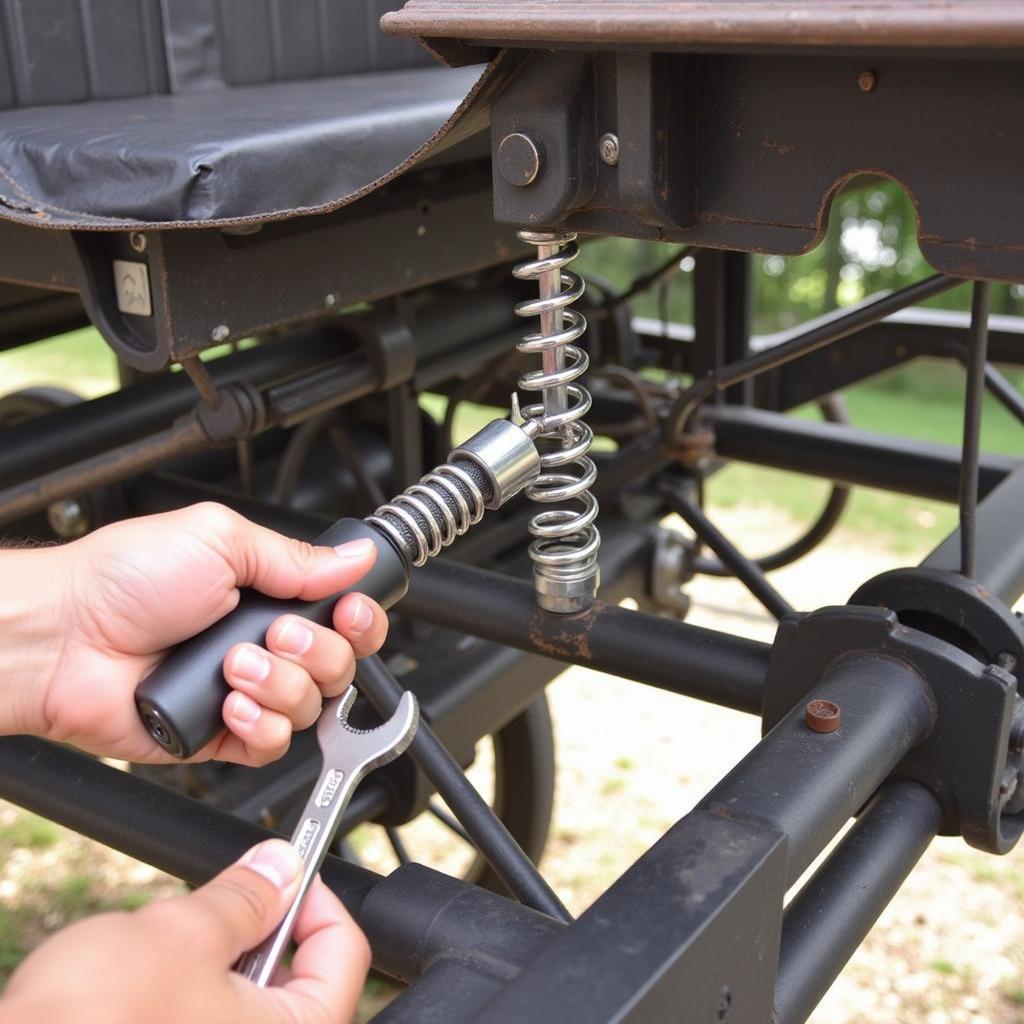Horse Buggy Seat Springs are an essential component for a comfortable ride, absorbing shocks and bumps along the way. Whether you’re restoring a vintage buggy or simply want to improve your current ride, understanding the nuances of these springs is crucial for both horse and rider comfort. This guide delves into the various aspects of horse buggy seat springs, from types and materials to maintenance and replacement.
Understanding the Importance of Horse Buggy Seat Springs
The primary function of horse buggy seat springs is to provide a smoother ride. Without them, every jolt and bump from the road would be transferred directly to the passengers. This can not only be uncomfortable but also potentially harmful, especially on longer journeys. Springs act as a cushion, absorbing the impact and minimizing the jarring effect. This not only increases comfort but also reduces fatigue, allowing for longer and more enjoyable rides. Furthermore, properly functioning springs protect the buggy’s frame from stress, extending its lifespan.
Different Types of Horse Buggy Seat Springs
Several types of springs are used in horse buggy seats, each offering unique characteristics. Understanding these differences is key to choosing the right spring for your needs.
- Leaf Springs: These are the most traditional type, consisting of layers of metal stacked together. They provide a robust and reliable suspension, ideal for heavier buggies.
- Coil Springs: Coil springs offer a smoother, more responsive ride compared to leaf springs. They are often preferred for lighter buggies and offer a more modern feel.
- Elliptical Springs: Elliptical springs combine the benefits of both leaf and coil springs, offering a balance of strength and comfort. They are a popular choice for both vintage and modern buggies.
Choosing the Right Material for Horse Buggy Seat Springs
The material used for the springs also plays a significant role in their performance and longevity. Common materials include:
- Steel: Known for its strength and durability, steel is the most common material for buggy springs. It’s capable of withstanding heavy loads and offers good resistance to wear and tear.
- High-Carbon Steel: This type of steel offers even greater strength and resilience compared to standard steel, making it ideal for heavy-duty applications.
- Titanium: Although more expensive, titanium offers exceptional strength-to-weight ratio and superior corrosion resistance, making it a premium option.
 Different Types of Horse Buggy Seat Springs
Different Types of Horse Buggy Seat Springs
Maintaining and Replacing Your Horse Buggy Seat Springs
Proper maintenance is essential for ensuring the longevity and performance of your horse buggy seat springs. Regular inspection is crucial to catch any signs of wear or damage early. Lubrication helps to prevent rust and corrosion, while tightening bolts ensures that the springs remain securely in place.
When should you replace your springs? Look out for signs like sagging, cracking, or excessive bouncing. These indicate that the springs are worn out and need replacement. Choosing the correct replacement springs is critical. Consider factors like the buggy’s weight, the intended use, and the desired ride quality.
How to Install Horse Buggy Seat Springs
Installing horse buggy seat springs requires careful attention to detail. It’s often best to consult a professional if you are not comfortable working with mechanical components. However, for those with some mechanical experience, here’s a simplified overview:
- Gather the necessary tools: You’ll need wrenches, sockets, and possibly a jack or lift.
- Remove the old springs: Carefully detach the old springs from the buggy frame and seat.
- Install the new springs: Attach the new springs, ensuring they are properly aligned and secured with the correct bolts and hardware.
- Test the springs: Check for proper function and ensure a smooth, comfortable ride.
 Installing Horse Buggy Seat Springs
Installing Horse Buggy Seat Springs
Why Quality Springs Matter
Investing in quality horse buggy seat springs is a worthwhile investment. High-quality springs not only provide a more comfortable ride but also last longer, reducing the need for frequent replacements. They also contribute to the overall safety and stability of the buggy.
“Don’t underestimate the importance of good springs,” advises Johnathan Miller, a seasoned carriage restorer with over 30 years of experience. “They’re essential for both comfort and safety.”
Choosing the Right Horse Buggy Seat Springs for Your Needs
Choosing the right springs depends on several factors, including the type of buggy, its weight, and the terrain you typically drive on. For rough terrain, heavier springs are generally preferred. Lighter buggies may benefit from more flexible springs.
“Match the springs to your buggy and your driving conditions,” recommends Sarah Jenkins, a renowned equestrian and buggy enthusiast. “It’s the key to a comfortable and enjoyable ride.”
Conclusion
Horse buggy seat springs are a vital component for a comfortable and safe ride. Understanding the different types, materials, and maintenance requirements will help you choose and care for the right springs for your buggy. Investing in quality springs ensures a smoother, more enjoyable experience for both horse and rider. Remember to consider your specific needs and consult with a professional if you have any questions or concerns about selecting or installing horse buggy seat springs.
FAQ
-
What are the most common types of horse buggy seat springs? Leaf, coil, and elliptical springs are the most common types.
-
How often should I inspect my buggy springs? Inspect them regularly, ideally before and after each ride, and more thoroughly every few months.
-
What are signs that my springs need replacing? Sagging, cracking, and excessive bouncing indicate worn-out springs.
-
What material is best for buggy springs? Steel and high-carbon steel are common and durable, while titanium offers a premium, lightweight option.
-
Can I install buggy springs myself? While possible with mechanical experience, it’s often best to consult a professional.
-
How do I choose the right springs for my buggy? Consider the buggy’s weight, intended use, and the terrain you typically drive on.
-
Why are quality springs important? They provide a more comfortable ride, last longer, and contribute to overall buggy safety.
Need further assistance? Contact us at Phone Number: 0772127271, Email: [email protected] Or visit us at: QGM2+WX2, Vị Trung, Vị Thuỷ, Hậu Giang, Việt Nam. Our customer service team is available 24/7.